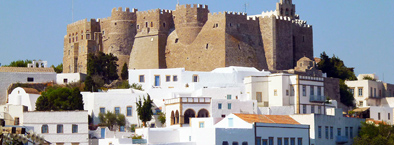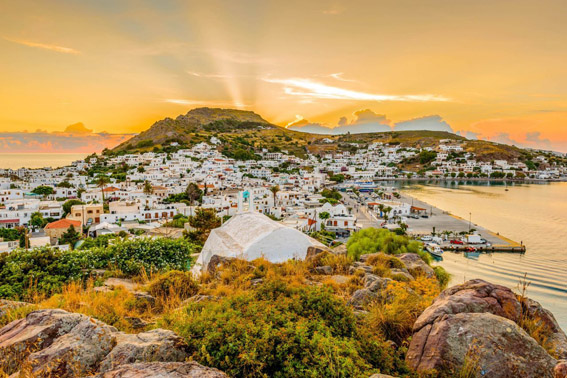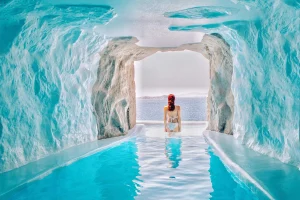In ancient mythology, Patmos was an island under the sea. Goddess Artemis often visited a mainland across the shore from Patmos, called Caria
There she met the moon goddess Selene, that shed her light on the ocean, presenting the sunken island of Patmos, and convincing Artemis to allow the island to rise from the sea.
With the help of her brother Apollo, Artemis persuaded Zeus to bring life to Patmos. The island’s residents named the island Litois as a proof of devotion to the goddess Artemis, who was also named Litoida because she was the daughter of Lito.

Patmos is internationally known as the Jerusalem of the Aegean or the island of the Apocalypse, for it is the place where the Book of Revelation was written by Saint John, who found refuge on the island in the 1st century A.D., when exiled by the Roman Emperor Domitian. On account of its steep morphology, the island was used as a place of exile by the Romans.
The Book of Revelation was written in 95 A.D. in the Holy Cave of Apocalypse, where Saint John heard the voice of God talking to him, according to prevailing theory.
The cave was later turned into a place of worship, and it is still open to committed Christians.
It is considered as one of the most important religious destinations globally. It binds both devotion and mysticism, inviting everyone for a journey of multiple experiences.
At the same time the island impresses with its cultural tradition, its charming coves and villages, and its natural beauty.
It is a radiating divine land, urging each individual to come and encounter the spiritual and mystical aura.
PATMOS SIGHT-SEEING
Saint John Monastery
Built in 1088 by Christodoulos Latrinos, the Saint John monastery (Agios Ioannis Theologos), sits high on the hill above Chora, and it is the most important religious and cultural center on the island which is visible from every part of Patmos.
Buildings of different ages form the Monastery, containing 99 cells, 10 chapels, a Library of 890 handwritten codes, and 13,000 documents about the history of the site.
Apocalypse Cave
When Saint John was exiled by the Roman Emperor Domitian, he had turned the cave into his home and consequently, the cave became the center of his revelation, which he dictated to his follower Prohorus and this led to the making of the last book of the bible, the Book of the Apocalypse. In 1999, the cave was declared a world heritage site by UNESCO. Today, a spiritual leader or a monk can be found sitting on the rock and talking to the tourists about the story of the Apocalypse and how the book was written.
Monastery of Zoodochos Pighi
Zoodochos Pigi means life-giving source. Founded by the monk Parthenios Pagkostas, under the patriarch Timothy the 2nd, the Convent of Zoodochos Pigi, was built in 1607. It is located southwest of the big Monastery. Presently, 15 nuns busy themselves with embroideries of clerical vestments in the convent and the art of needlework.
They live under strict rules and are also involved in social welfare activities. A notable ritual in this convent is the Celebration on Friday after Easter.
Patmian Ecclesiastic School
Founded by Makarios Kalogeras in 1713, the Patmian School is located near the Cave of the Apocalypse on Patmos Island. Also mentioned as the General School of the Nation, the foundation of the Patmian Ecclesiastic School was the most significant event of the 18th century.
Makarios Kalogeras undertook philosophical and theological studies in the patriarchal school of Constantinople. However, Makarios’s desire to teach, urged him to return to Patmos and create the School close to the Cave of the Apocalypse.
Ecclesiastical Museum
A small but fascinating museum, the Ecclesiastical Museum of Patmos is found on the premises of the Monastery of Saint John, atop Chora, the capital of the island. It contains valuable manuscripts, priest vestments, portable icons from the Byzantine and post-Byzantine times, items used in the Holy Mass and others. The 11th-century icon of Saint Nicolas, is among the most important icons in the Ecclesiastic Museum of Patmos.
Folklore Museum The Folklore Museum, is a small museum that is accommodated in the residence of Simantiri Family in Chora Patmos. Constructed in 1625 by craftsmen from Izmir Turkey, this elegant mansion is still inhabited to this day.
The lavish collection includes items from the 14th century until the 19th century. Among them, visitors can see old photographs, wooden furniture, Russian style icons, and paintings.
SETTLEMENTS
Skala Village
Located right at the center of the island, Skala is the largest settlement and the main port of Patmos. The lovely settlement is constructed around the charming port and constitutes the commercial and trade center of Patmos island.
A number of sights in the settlement of Skala are really worth seeing. Among them is the church of Panagia Koumana, the ruins of an ancient acropolis, and the 17th century Church of Agia Paraskevi of Cavos.
Chora Village
Found in the south-central part of the island, Chora is the capital of Patmos and a few kilometers south of the main port of Patmos called Skala. During the 12th century, the traditional settlement was constructed around the impressive Monastery of Saint John the Theologian.
Between the 16th and 17th century, the settlement of Chora flourished. During that time, captain residences and beautiful mansions were built from the wealthy families of that era.
SUNBATHING
Kampos
The cosmopolitan crystal clear beach of Kampos offers fantastic fish tavernas and sea sport facilities. The lovely bay is located on the northern side of the island.
Psili Ammos
The beach of Psili Ammos (thin sand), is only accessible by boat. This picturesque cove has very soft golden sand and clean waters, with many tamarisk trees providing shade.
Vagia
Vagia beach includes pebbles and shady trees, offering a quiet and peaceful time. It is said to have the coldest waters on Patmos, and is located 11 km southeast of Skala.
Lambi
Lambi beach is covered with rare multi-colored pebbles. The name Lambi means shining, which was given because of the sun that reflects against the beautiful stones and the crystal waters of the bay.
NOTE: The small and mainly uninhabited islets of Arkoi are definitely worth visiting. Catch a boat from the settlement of Skala, and make sure you visit Marathi for fresh delicious fish and crystal clear waters.













